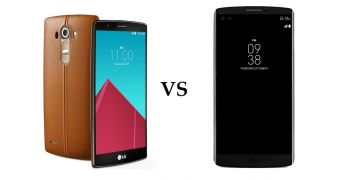LG has just announced its first smartphone from the new V line, a product called the V10. The phone is obviously meant to sit above the LG G4 flagship, which was launched this summer, coming with a nifty set of specs and atypical functionalities.
While the LG V10 and LG G4 might feature a common backbone, in what follows you’ll see there’s plenty of reason you should probably fast-forward over the LG G4 and go straight to the LG V10.
| Product | LG V10 | LG G4 |
| Design | Stainless steel frame with silicon back | Plastic with leather back |
| Display | 5.7-inch QHD resolution | 5.5-inch with QHD resolution |
| Processor | Snapdragon 808 | Snapdragon 808 |
| RAM | 4GB | 3GB |
| Main Camera | 16MP with laser autofocus | 16MP with laser autofocus |
| Frontal Camera | dual 5MP setup | 8MP |
| Security | fingerprint scanner | none |
| Battery | 3,000mAh | 3,000mAh |
| Internal storage | 64GB - base | 32GB - base |
| External storage | microSD card | microSD card |
| Operating system | Android 5.1.1 Lollipop | Android 5.1.1 Lollipop |
| Dimensions | 159.6 x 79.3 x 8.6mm | 148 x 76.1 x 6.3-9.8mm |
Design
The LG G4 is a good-looking smartphone coming with an optional leather skin back that looks quite stylish. Additionally, the phone measures 148 x 76.1 x 6.3-9.8mm and weighs only 155g, which makes for a pretty good-looking device.
However, with the LG V10, the company is taking things to a different level by using a stainless steel frame and a damage-resistant silicon back. Obviously, LG was keen on making a durable phone here, one that wouldn’t be damaged by an accidental drop. The V10 measurements are 159.6 x 79.3 x 8.6mm and 192g in weight.
As you can see, the LG V10 tends to be a bit bulkier, but that’s because we’re dealing with a Dura Frame, reinforced corners, and MIL-STD-810G standard shock resistance. All these make for a pretty sturdy device that won’t break easily.
Display
The LG V10 makes a debut with a 5.7-inch IPS display with 2450 x 1440 pixel resolution and 513ppi, while the secondary display is of a 2.6-inch variety with 150 x 1040 resolution (same 513ppi).
The secondary display brings extra functionality, as it was designed to show notifications, the time, weather, date and the battery icon. Even more, while the main display is on, the secondary screen can be used to run shortcuts or even open the most used apps.
Similarly, the LG G4 features a (smaller) 5.5-inch display with 2560 x 1440 pixel resolution and 538ppi (it’s a little sharper, due to its smaller size).
Hardware
The two smartphones are quite similar in the hardware department, but there are a few things that differ. Both models run on the hexa-core Snapdragon 808 processor, but the G4 only has 3GB of RAM and 32GB of internal storage as a standard, while the V10 features 4GB of RAM and 64GB of internal storage.
Both models have microSD card slots for memory expansion and rely on a 3,000mAh battery, although the LG G4 might last a little bit longer, given the fact that it features a smaller display.
We should also mention that the V10 features a fingerprint scanner, while the G4 does not.
Camera
One of the reasons the V10 stands out is the camera department. For starters, there’s the dual 5MP camera setup that allows users to take 120-degree group shots. The G4 only has an 8MP front-facing camera, by comparison.
The rear part is reserved for a 16MP shooter in both cases, one that comes with laser autofocus. Still, the V10 features the unique manual video mode that includes adjusting the shutter speed, frame rate, ISO and white balance.
Furthermore, the latest LG smartphone bundles ESS Technology 32-bit DAC, so when you connect to the phone, you’ll be able to tweak sounds for optimal results.
Verdict
It’s pretty obvious that the LG V10 comes with a number of important improvements that really set the model apart from the G4. Still, the previous flagship is a bit slimmer and lighter overall, in case you are looking for a more portable device.
However, the secondary display, camera benefits and frontal dual camera setup can’t be ignored. Our only regret is that LG should have saved this model for a better processor. If rumors are correct, the first devices with a Snapdragon 820 under the hood should arrive on the market by December. If only LG had waited until then!

 14 DAY TRIAL //
14 DAY TRIAL //